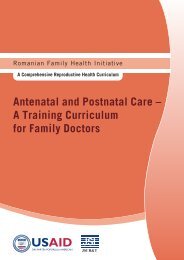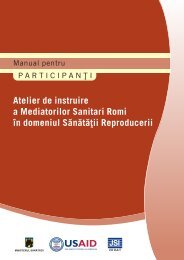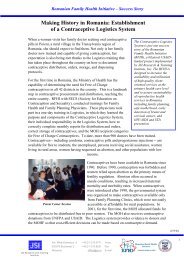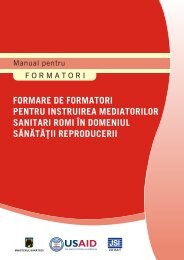Training of Roma Health Mediators in Reproductive Health
Training of Roma Health Mediators in Reproductive Health
Training of Roma Health Mediators in Reproductive Health
Create successful ePaper yourself
Turn your PDF publications into a flip-book with our unique Google optimized e-Paper software.
3) poses open questions <strong>in</strong> order to help the person reflect on his/her problem and<br />
alternatives, and to f<strong>in</strong>d a solution to his/her own problem. Active listen<strong>in</strong>g<br />
communicates acceptance <strong>of</strong> the person <strong>in</strong> that the “helper” does not communicate<br />
judgments nor solutions. It facilitates decision-mak<strong>in</strong>g by the <strong>in</strong>dividual.<br />
‣ In what way is active listen<strong>in</strong>g important to <strong>in</strong>terpersonal communication <strong>in</strong><br />
reproductive health?<br />
Women may have questions, concerns and problems that <strong>in</strong>fluence their ability to adopt<br />
certa<strong>in</strong> practices that would benefit their health and the health <strong>of</strong> their young children. They<br />
may pose <strong>in</strong>formational questions which <strong>in</strong> fact represent rumors, beliefs, anxieties or<br />
disagreement with a partner. Active listen<strong>in</strong>g is useful to help br<strong>in</strong>g out what may be beh<strong>in</strong>d<br />
a woman’s <strong>in</strong>itial statements, questions or responses, <strong>in</strong> order to be able to better respond to<br />
these concerns and to anyth<strong>in</strong>g that may prevent her from mak<strong>in</strong>g a positive change <strong>in</strong><br />
behavior.<br />
Steps <strong>in</strong> learn<strong>in</strong>g active listen<strong>in</strong>g<br />
Expla<strong>in</strong> that active listen<strong>in</strong>g is made up <strong>of</strong> three techniques:<br />
• Passive listen<strong>in</strong>g<br />
• Paraphrase<br />
• Open questions<br />
Add that:<br />
• You will demonstrate each step<br />
• At the end <strong>of</strong> the session, all participants will have an opportunity to practice Active<br />
Listen<strong>in</strong>g when they participate <strong>in</strong> role plays <strong>of</strong> <strong>in</strong>terpersonal communication.<br />
• This is only an <strong>in</strong>troduction. Mastery <strong>of</strong> the techniques requires cont<strong>in</strong>ued practice.<br />
Refer to the first component <strong>of</strong> active listen<strong>in</strong>g; passive listen<strong>in</strong>g. Ask the group:<br />
‣ What do you do when you listen to someone passively? Why?<br />
Listen without speak<strong>in</strong>g <strong>in</strong> order to hear and understand what the other person is say<strong>in</strong>g<br />
Invite participants to observe a demonstration <strong>of</strong> passive listen<strong>in</strong>g (done by 2 tra<strong>in</strong>ers or a<br />
tra<strong>in</strong>er and a participant). One <strong>in</strong>dividual (a tra<strong>in</strong>er or a participant) takes the role <strong>of</strong> a<br />
woman <strong>in</strong> the community and expla<strong>in</strong>s a problem, need or concern. The other <strong>in</strong>dividual (a<br />
tra<strong>in</strong>er) takes the role <strong>of</strong> the mediator, respond<strong>in</strong>g with non-verbal and one-word responses<br />
(“Yes”, “I see”, “Mm-mm”, “Right”, “OK”, “Uh-huh”, nodd<strong>in</strong>g etc, and ma<strong>in</strong>ta<strong>in</strong><strong>in</strong>g eye<br />
contact) to encourage the woman to cont<strong>in</strong>ue to expla<strong>in</strong> her concern. (1 m<strong>in</strong>ute)<br />
Ask the group:<br />
‣ What did the mediator do?<br />
‣ What jests did she use?<br />
210<br />
RFHI/JSI <strong>Roma</strong>nia <strong>Tra<strong>in</strong><strong>in</strong>g</strong> <strong>of</strong> RHMs <strong>in</strong> <strong>Reproductive</strong> <strong>Health</strong> Session 14: Interpersonal Communication








